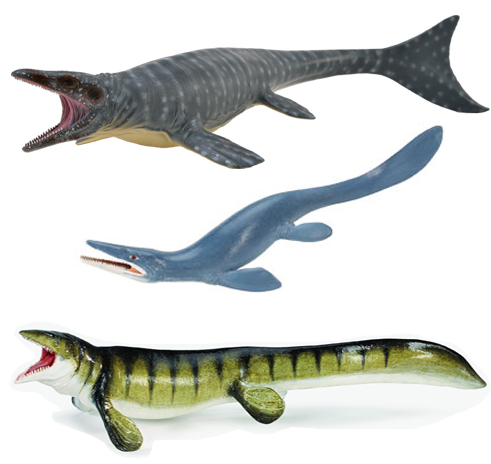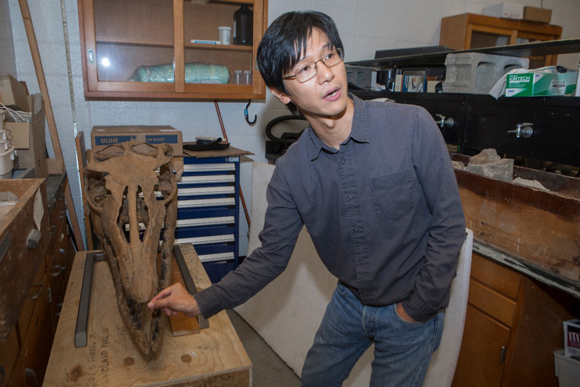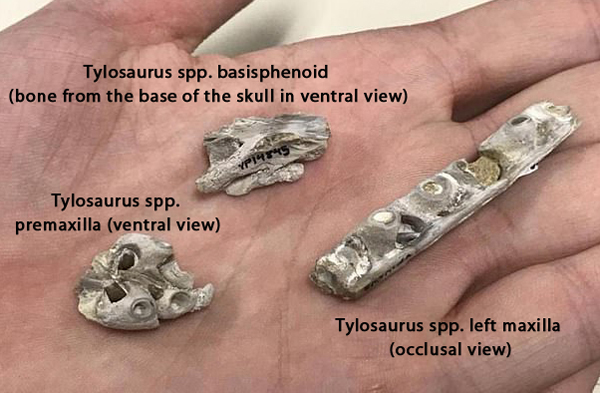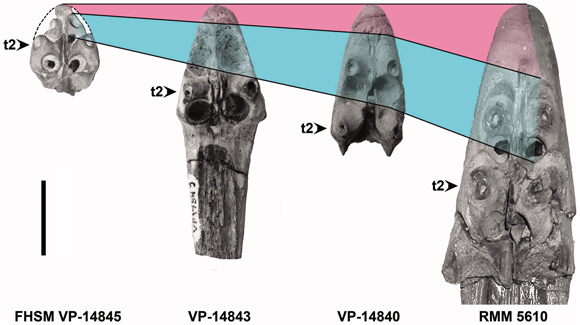Baby Tylosaurus Provides Clues to How Marine Reptiles Hunted
Baby Tylosaurus Fossils Shed Light on Tylosaurus Hunting Strategy
The fragmentary remains of a baby Tylosaurus may have provided palaeontologists with an insight into how the giant and powerful marine predator Tylosaurus hunted. Analysis of the front portion of the jaw shows that this tiny terror lacked a deep rostrum, whilst older, larger specimens and the adults all had these bony protrusions. Scientists writing in the “Journal of Vertebrate Paleonotology” hypothesise that Tylosaurus rammed its victims with its snout in a similar fashion to a hunting method observed in extant Orcas.
Fearsome Mosasaurs – How Did These Predators Subdue Their Prey?

Picture credit: Everything Dinosaur
Baby Tylosaurus Fossil
Scientists are aware that pods of Orcas (Orcinus orca), tend to specialise in different types of prey, some hunt fish, others specialise in hunting other marine mammals whilst others are generalists, however, it is known that Orcas tend to stun prey such as seals and dolphins by ramming them with their snouts. A study of the smallest Tylosaurus skull fossils found to date, suggest that as these animal’s grew their snouts (rostrums) became elongated and more robust. It is suggested that these predators rammed their victims in the same way that some living Killer Whales do.
Little Killer/Tiny Tylosaurus
Lead author of the scientific paper, Professor Takuya Konishi, explained that he examined fossils of a very young Tylosaurus whilst working on his master’s degree in 2004. The fossils came from an animal with a skull length of around thirty centimetres, approximately 1/6th the size of an adult Tylosaurus skull.
The fossils come from the Smoky Hill Chalk Member of the Niobrara Chalk of western Kansas, deposits that were laid done in the shallow Western Interior Seaway. The baby Tylosaurus is estimated to have lived around 85 million years ago. The fossils had been originally found in 1991, by palaeontologist Michael Everhart (Sternberg Museum of Natural History), the small size and fragmentary nature made initial identification difficult and the fossils has been assigned to another type of mosasaur, a Platecarpus, remains of which are relatively common in the Smoky Hill Chalk Member.
Tiny Fossil Fragments Identified as Neonate Tylosaurus
Picture credit: Christina Byrd/Sternberg Museum of Natural History with additional annotation by Everything Dinosaur
Lack of a Prominent Snout
The lack of a snout puzzled the scientists who were unable to tie this material to other Tylosaurine remains. The Platecarpus assignment seemed the best fit, then Professor Konishi had his “eureka” moment. The elongated rostrum of Tylosaurus might develop as the animal grew, this anatomical feature might not be present in very young examples of this genus. While Platecarpus and other members of the Mosasauridae have teeth that begin virtually at the tip of their snouts, mature Tylosaurus possess a bony protrusion called a rostrum that extends out from its face, a similar feature is found in Orcas.
The research team speculate that this rostrum might have served as a battering ram and protected the marine reptile’s teeth as it slammed into its prey.
Professor Konishi takes up the story:
“Having looked at the specimen in 2004 for the first time myself, it too took me nearly ten years to think out of that box and realise what it really was, a baby Tylosaurus yet to develop such a snout.”
The Ontogeny of Tylosaurus
Picture credit: Journal of Vertebrate Paleontology
Specimen Number FHSM VP-14845
The picture (above) shows various Tylosaurus fossil specimens. Specimen number FHSM VP-14845 is from the neonate Tylosaurus (left) and moving towards the right, the rostrums denote progressively older, larger Tylosaurus specimens. The researchers identified greater anteroposterior alignment of two pairs of premaxillary teeth in association with alveolar elongation (tooth socket spacing). The abbreviation t2 denotes the second premaxillary tooth, this alveolar elongation slows down as the Tylosaurus ages, as seen here between specimens FHSM VP-14840 and RMM 5610. In contrast, the rostrum continues to grow and to become deeper and more robust.
Professor Konishi and His Co-workers Suggest Tylosaurus Used Its Snout to Ram Prey

Picture credit: Joseph Fuqua II/University of Cincinnati Creative Services
The Possibility of Misidentified Fossil Material
The scientists suggest that, as Tylosaurus developed its “tell-tale” snout as it grew, then this could mean that other fossil specimens of mosasaurs from the Western Interior Seaway may have been mistakenly classified as other types of mosasaur.
For models and replicas of Tylosaurus and other marine reptiles: CollectA Prehistoric Life Figures.
A spokesperson from Everything Dinosaur commented:
“What was once thought to be a diagnostic feature of Tylosaurus, a robust and elongated snout, might not be as diagnostic as previously thought. This means that short-snouted fossil remains assigned to other types of mosasaur could, actually represent juvenile Tylosaurus specimens.”
The scientific paper: “The Smallest Known Neonate Individual of Tylosaurus (Mosasauridae, Tylosaurinae) Sheds New Light on the Tylosaurine Rostrum and Heterochrony” by Takuya Konishi, Paulina Jiménez-Huidobro and Michael W. Caldwell published in the Journal of Vertebrate Paleontology.
Visit the Everything Dinosaur website: Everything Dinosaur.



